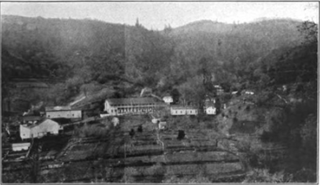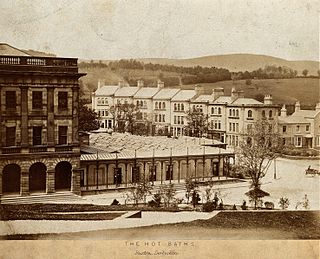
Sharon Springs is a village in Schoharie County, New York, United States. The population was 558 at the 2010 census. Its name derives from the hometown of the first colonial settlers, Sharon, Connecticut, and the important springs in the village. Sharon Springs, Kansas, likewise was settled by former residents of this upstate New York village.

Addison, commonly known as Webster Springs, is a town in and the county seat of Webster County, West Virginia, United States. Although it was incorporated as Addison in 1892, it is more frequently referred to as Webster Springs, the name of the town's post office. It was named for Addison McLaughlin, upon whose land the town was originally laid out. The population was 731 at the 2020 census.

The Omni Bedford Springs Resort is a resort hotel which is located outside of Bedford, Pennsylvania. Established in 1806, it is one of the last and best-preserved of 19th-century resort hotels based around mineral springs.

Yessentuki is a city in Stavropol Krai, Russia, located in the shadow of Mount Elbrus at the base of the Caucasus Mountains. The city serves as a railway station in the Mineralnye Vody—Kislovodsk branch, and is located 43 kilometers (27 mi) southwest of Mineralnye Vody and 17 kilometers (11 mi) west of Pyatigorsk. The city is renowned for its mineral springs and therapeutic spas, and is part of the Caucasian Mineral Waters region.

A spa is a location where mineral-rich spring water is used to give medicinal baths. Spa towns or spa resorts typically offer various health treatments, which are also known as balneotherapy. The belief in the curative powers of mineral waters goes back to prehistoric times. Such practices have been popular worldwide, but are especially widespread in Europe and Japan. Day spas and medspas are also quite popular, and offer various personal care treatments.

Harbin Hot Springs is a hot spring retreat and workshop center situated at Harbin Springs in Lake County, Northern California. Operated by Heart Consciousness Church, a non-profit, it is named after Matthew Harbin, a pioneer who settled in the Lake County area. Located approximately two hours north of the San Francisco Bay Area, in the United States, the facility suffered partial destruction in the Valley Fire in September 2015, resulting in its temporary closure. It partially reopened in January 2019, including the main pools and sauna, along with a limited cafeteria service.

A mud bath is a therapeutic spa treatment that involves soaking in a bath of warm mud, often in a natural hot spring or geothermal pool. Mud baths have been used for centuries as a way to promote health and relaxation, and are still popular today in many parts of the world.
Castor Creek or Bayou Castor is a 103-mile-long (166 km) tributary of the Little River in north-central Louisiana in the United States. Via the Little, Ouachita and Red rivers, it is part of the watershed of the Mississippi River.

The Royal Pump Rooms is a cultural centre on the Parade in Leamington Spa, Warwickshire, England. It was the most famous of several spa baths opened in Leamington between the late-18th and mid-19th centuries. People would travel from throughout the country, and indeed Europe, to benefit from treatments using the town's healing waters. When 'taking the waters' became less fashionable after the mid-19th century the Pump Rooms became Leamington's only surviving spa facility, later also being extended to include the town's public swimming pool. After a major redevelopment in 1997-99 the building now houses Leamington Spa Art Gallery & Museum, a public library, a Tourist Information Centre, cafe and assembly rooms. It is a Grade II listed building.

Hot Lake Hotel is a historic Colonial Revival hotel originally built in 1864 in Hot Lake, Union County, Oregon, United States. The hotel received its namesake from the thermal spring lakes on the property, and operated as a luxury resort and sanitorium during the turn of the century, advertising the medicinal attributes of the mineral water and drawing visitors worldwide. It is also the first known commercial building in the world to utilize geothermal energy as its primary heat source.

Ķemeri resort is a part of Jūrmala in Latvia, 44 km from Riga. From 1928 to 1959, Ķemeri was a separate town, famous for healing mud baths and luxurious hotels. Approximately 2,200 inhabitants live there, while the main hotel is under reconstruction.

Sulphur Springs is a geothermal field on the island of Saint Lucia. It is located to the southwest in the district of Soufriere, a name given by the French meaning 'sulphur mine', because of the proximity of the town to the site. It is the most popular tourist destination in Saint Lucia, with approximately 200,000 annual patrons to the park, and is known as 'the world's only drive-in volcano'.

Wilbur Hot Springs, formerly known as Simmons Hot Springs, is a naturally occurring historic hot spring approximately 22 miles west of Williams, Colusa County, in northern California. It is about 2 hours by car northeast of the San Francisco Bay Area. It was developed as a spa in the 19th century, and since its acquisition in the 1970s by therapist Richard Louis Miller, has been operated as a spa resort and personal retreat. The adjacent valley was added to the property as a nature reserve protected by covenant.

Gilman Hot Springs, also known as San Jacinto Hot Springs or the Relief Springs, is a hot spring system in the Inland Empire area of Southern California. Located near Potrero Creek, the San Jacinto River, and California State Route 79, the springs system consists of "about half a dozen" springs named for the Mexican land grant Rancho San Jacinto Viejo.

Beppu Onsen (別府温泉) is an extensive hot spring system in the city of Beppu, Ōita, Japan. There are eight distinct major thermal spring zones called "Beppu Hatto"(別府八湯).
Mudbaden is an unincorporated community in Sand Creek Township, Scott County, Minnesota, United States.

Hot Wells is the site of a cultural historical park in San Antonio, Texas. The park complements Texas' only World Heritage Site—the nearby San Antonio Missions National Historical Park—and the Mission Reach of the San Antonio River Walk. The park is located on the east side of the San Antonio River, directly across South Presa Street from the San Antonio State Hospital, along the tracks of the Southern Pacific Railroad and within sight of Mission San José across the river. Prior to the arrival of the Spanish, the land was originally inhabited by Coahuiltecan peoples.

The Buxton Baths using natural thermal spring water are in Buxton, Derbyshire, England. The baths date back to Roman times and were the basis for developing Buxton as a Georgian and Victorian spa town. The present buildings of the Thermal Baths and the Natural Mineral Baths were opened in the 1850s. They are positioned either side of the Buxton Crescent at the foot of The Slopes in the town's Central Conservation Area. They are both Grade II listed buildings designed by Henry Currey, architect for the 7th Duke of Devonshire.

The Ripon Spa Baths are a grade II listed building in Ripon, North Yorkshire, England. It was built between 1904–05 as a spa but failed to compete with the larger facilities at nearby Harrogate. In 1936 a new pool was constructed to the rear and the facility converted to a swimming baths. The building is noted for its ornate terracotta-clad frontage and received listed building protection in 1980. Harrogate Borough Council proposed selling the building for housing development in 2008 on the grounds that it required significant structural repair. The sale was cancelled but in 2021 the council made a new proposal to sell the structure.

Paso Robles Hot Springs is a system of geothermal hot springs in the area of Paso Robles in San Luis Obispo County, California. They were developed in the late 19th and early 20th century.






















